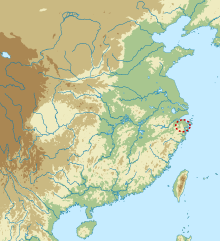فرهنگ همودو
ظاهر
 | |||||||
| مکان | Eastern جمهوری خلق چین | ||||||
|---|---|---|---|---|---|---|---|
| دوران | چین نوسنگی | ||||||
| تاریخها | حدود ۵۵۰۰ (پ.م) تا حدود ۳۳۰۰ (پ.م) | ||||||
| پس از | فرهنگ کویاهوکیائو | ||||||
| پیش از | فرهنگ لیانگژو | ||||||
| نامِ چینی | |||||||
| زبانهای چینی | 河姆渡文化 | ||||||
| |||||||


فرهنگ همودو (انگلیسی: Hemudu culture) یک فرهنگ باستانشناختی مربوط به دوران نوسنگی بود که از حدود ۵۵۰۰ (پ.م) تا حدود ۳۳۰۰ (پ.م) در جنوب خلیج هانگژو در چجیانگ (در چین امروزی) سکونت داشت. [۱] یک محوطه مربوط به همودو در ۲۲ کیلومتری شمالغربی نانگبو در سال ۱۹۷۳ کشف شد. محوطههای دیگری مربوط با این فرهنگ در جزیرهٔ جواشان کشف شدهاند.
مردمان این فرهنگ در آبسراها و خانههای کشیدهٔ اشتراکی میزیستند.[۲] گفته میشود آنها نخستین افرادی بودند که به کاشتن برنج دست زدند.[۳]
منابع
[ویرایش]- مشارکتکنندگان ویکیپدیا. «Hemudu culture». در دانشنامهٔ ویکیپدیای انگلیسی، بازبینیشده در ۱۶ ژوئیه ۲۰۱۷.
- ↑ Wang (2001), p. 209.
- ↑ Maisel, Charles Keith (1999). Early Civilizations of the Old World: The Formative Histories of Egypt, the Levant, Mesopotamia, India and China. Psychology Press. p. 288. ISBN 978-0-415-10975-8.
- ↑ Fuller, Dorian Q, Ling Qin, Yunfei Zheng, Zhijun Zhao, Xugao Chen, Leo Aoi Hosoya, and Guo-ping Sun (2009) "The Domestication Process and Domestication Rate in Rice: Spikelet bases from the Lower Yangtze". Science 323: 1607–1610 doi:10.1126/science.1166605
- Fuller, D.Q.; Qin, Ling (2010), "Declining oaks, increasing artistry, and cultivating rice: the environmental and social context of the emergence of farming in the Lower Yangtze Region", Environmental Archaeology, 15 (2): 139–159, doi:10.1179/146141010X12640787648531.
- Liu, Li; Chen, Xingcan (2012), The Archaeology of China: From the Late Paleolithic to the Early Bronze Age, Cambridge University Press, ISBN 978-0-521-64310-8.
- Wang, Haiming (2001), "Majiabang", in Peregrine, Peter N.; Ember, Martin (eds.), Encyclopedia of Prehistory, Volume 3: East Asia and Oceania, Springer, pp. 206–221, ISBN 978-0-306-46257-3.
پیوند به بیرون
[ویرایش]در ویکیانبار پروندههایی دربارهٔ فرهنگ همودو موجود است.
